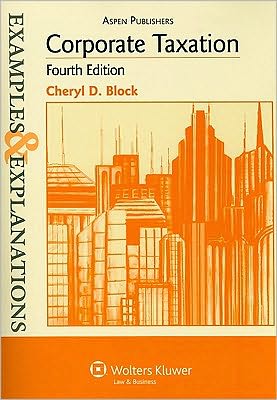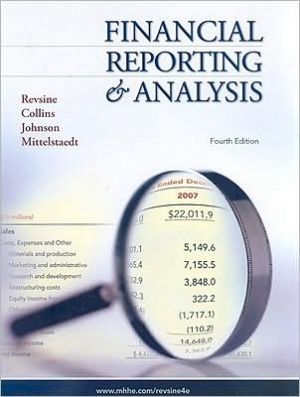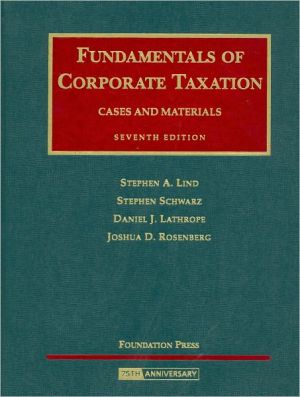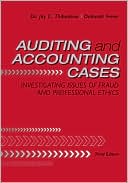Corporate Taxation (Examples and Explanations Series)
Examples & Explanations: Corporate Taxation offers a remarkably clear treatment of a complex area of tax law. Demystifying Subchapter C, Cheryl D. Block methodically explains all of the tax issues that arise from the formation of the corporation to liquidation. Students learn by applying the concepts in multiple problem sets and comparing their answers to Block’s thorough analysis.\ Making complicated tax laws understandable, this straightforward introduction to the principles of...
Search in google:
Block's (law, George Washington U.) textbook differs from others on corporate taxation in its inclusion of hypothetical questions—and their answers— at the end of most of the chapters, as well as the addition of diagrams illustrating corporate transactions. Provisions of the Economic Growth and Tax Relief Reconciliation Act of 2001 and the Jobs and Growth Tax Relief Act of 2003 have been incorporated into the updated third edition. Annotation ©2004 Book News, Inc., Portland, OR
PrefacexxiiiAcknowledgementsxxvPart 1Some Preliminary MattersChapter 1Introduction3The Corporate Income Tax-A Double Tax Regime3Computation and Rate Structure for the Tax on Corporate and Shareholder Income6Nonrecognition in the Subchapter C World16Incidence of the Corporate Tax17Chapter 2Choice of Form and Entity Classification19Introduction19Choice of Business Form20Classification of the Business Entity25Chapter 3The Corporate Capital Structure33Introduction33Distinguishing Debt from Equity35Losses from Investments in the Corporate Enterprise45Gains from Investment in the Corporate Enterprise47Conclusion48Part 2Corporate FormationChapter 4Incorporation and Other Contributions to Capital51Introduction51Shareholder Nonrecognition: [section]351 Eligibility Requirements and Underlying Policy53Operation of Shareholder Nonrecognition Rules67Tax Consequences to the Corporation74Contribution vs. Sale76Additional Contributions to Capital78Effect of Liabilities: [section]357 and Related Matters81Examples103Explanations105Part 3Corporate Midlife EventsChapter 5Nonliquidating Distributions117Introduction117Tax Consequences to the Shareholders118Definitions of Earnings and Profits127Special Rules for Corporate Shareholders130Tax Consequences to the Distributing Corporation135Distributions Involving Liabilities141Constructive Dividends143Examples144Explanations146Chapter 6Redemption Distributions155Introduction155Tax Consequences to Redeemed Shareholders157A Look at Attribution Rules: [section]318166Special Issues for Corporate Shareholders179Redemptions of Stock to Pay Death Taxes: [section]303180Redemptions Related to Inter-Shareholder Transfers and Bootstrap Acquisitions181Redemptions by Related Corporations: [section]304189Tax Consequences to the Corporation197Examples198Explanations200Chapter 7Stock Dividends209Introduction209Tax Consequences to the Shareholders211Tax Consequences to the Corporation220The Preferred Stock Bailout: [section]306 Stock221Examples235Explanations238Part 4Corporate Liquidation and Related IssuesChapter 8General Liquidation Rules245Introduction245Tax Consequences to Individual Shareholders: [section]331247Tax Consequences to the Liquidating Corporation: [section]336253Examples259Explanations262Chapter 9Liquidation of Subsidiaries271Introduction271Tax Consequences to the Parent Corporation: [section]332272Tax Consequences to Minority Shareholders: [section]331276Tax Consequences to the Liquidating Subsidiary: [section]337276Examples280Explanations282Part 5Corporate Acquisitions, Divisions, and Other Corporate RestructuringSubpart ATaxable AcquisitionsChapter 10Taxable Mergers and Acquisitions291Introduction291Taxable Asset Acquisitions296Taxable Stock Acquisitions303Stock Acquisitions Treated as Asset Acquisitions: [section]338305Special Problems Under [section]338: Affiliated Corporations and Consistency Rules318Creative Acquisition Strategies328Examples329Explanations332Subpart BTax-Free ReorganizationsChapter 11Introduction to Basic Corporate Reorganization Principles343Introduction343Categories of Reorganization344Overview and History: Doctrine Underlying Tax-Free Reorganizations346Overview of Corporate Reorganization Tax Consequences347Judicial Glosses on the Statute355Step-Transaction Doctrine376Meaning of "Party to a Reorganization" and "Plan of Reorganization"382Chapter 12Acquisitive Reorganizations385Introduction385Acquisitive Stock Reorganizations: The Basic Type B Reorganization387Acquisitive Asset Reorganizations: Basic Statutory Mergers and Consolidations395Acquisitive Asset Reorganizations: The Basic Type C Reorganization399Triangular Reorganizations406Nondivisive Type D Reorganizations421Acquisitive Reorganizations in Insolvency: The Type G Reorganization422Overlaps in the Acquisitive Reorganization Definitions423Proposals to Eliminate the Reorganization Definitions424Carryover of Tax Attributes Following Tax-Free Acquisitive Reorganizations425Examples427Explanations431Chapter 13Corporate Divisions445Introduction445Overview of [section]355 Requirements452A Closer Look at the [section]355 Requirements453Overlap of [section]368(a)(1)(D) and [section]355: Divisive Reorganizations466Tax Consequences to Shareholders and Other Distributees466Tax Consequences to the Corporation468Examples474Explanations476Chapter 14Recapitalization and Other Corporate Restructuring483Introduction483Recapitalizations: The Type E Reorganization485Mere Change in Identity, Form, or Place: Type F Reorganization498Examples499Explanations501Table of Cases507Table of Internal Revenue Code Sections509Table of Treasury Regulations and Revenue Rulings517Index521







